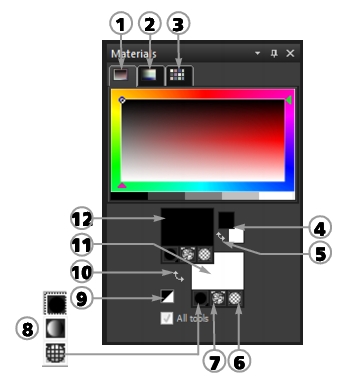Using the Materials palette
Corel PaintShop Pro lets you paint, draw, and fill with a variety of styles and materials.
• |
A style is a color, gradient, or pattern.
|
• |
A material is the style plus an optional texture.
|
Both styles and materials can be selected from the Materials palette.
You can display the Materials palette at any time. You can leave it open while you work, or you can display it only when you need it.
You can also reverse the foreground and background colors or materials.
Main components of the Materials palette
• |
Frame tab — displays an outer Hue rectangle and an inner
Saturation rectangle, as well as a strip containing white, three
shades of gray, and black. You can drag the vertical slider to adjust
lightness, and drag the horizontal slider to adjust saturation.
|
• |
Rainbow tab — displays the Available Colors panel, where you can
click to select a color. At the bottom of the tab you can click to
select white, black, or three shades of gray.
|
• |
Swatches tab — displays swatches, which are materials you can
save to use again. For more information about swatches, see
Working with swatches.
|
• |
Foreground and Stroke and Background and Fill Properties boxes
— display the current foreground and background materials,
which consist of the style (color, gradient, or pattern) and optional
texture. You can click either box to display the Material Properties
dialog box, in which you can set material options. These boxes can
be used in the following ways:
|
• |
You can use foreground materials for brush strokes and
background materials for fills.
|
• |
When you apply strokes with a brush (including the fill tools),
clicking lets you paint with the foreground material, and right-
clicking lets you paint with the background material.
|
• |
When you are using the Art Media tools, you can set the
foreground color for the pigment that you apply to the canvas.
|
• |
For text and vector shapes, you can set the foreground color for
the stroke (or outline) of the text or shape, and the background
color for the fill of the text or shape. For more information about
changing the color of text and vector objects, see To modify vector
object properties.
|
• |
Foreground and Background Color boxes — display the current
foreground and background color and let you set colors
regardless of current material
|
• |
Style button |
• |
Texture button |
• |
Set to Black and White button |
• |
Transparent button |
• |
All tools check box — specifies whether the selected foreground
and background materials apply to all tools. If the check box is
unmarked, the selected materials apply only to the active tool.
|
Why does the Materials palette have both properties and color boxes?
You can select colors by clicking the Foreground and Background Properties boxes, so you may wonder why the Materials palette also includes color boxes. The color boxes provide a quick way to change colors without changing the other materials. This means that you can select a new color even when the properties box displays a gradient or pattern.
If the properties boxes and the color boxes on the Materials palette are showing different colors, the brush paints with the gradient, texture, or pattern shown in the properties boxes rather than with the color in the color boxes. The colors shown in the color boxes become active when you select Color ![]() from the Style buttons for the Foreground and Background Properties boxes.
from the Style buttons for the Foreground and Background Properties boxes.
| To display or hide the Materials palette |
Edit workspace
• |
Choose View |
You can also close the palette by clicking the Close button |
| To swap the foreground and background colors or materials |
Edit workspace
• |
From the Materials palette, click the Swap Colors button |
